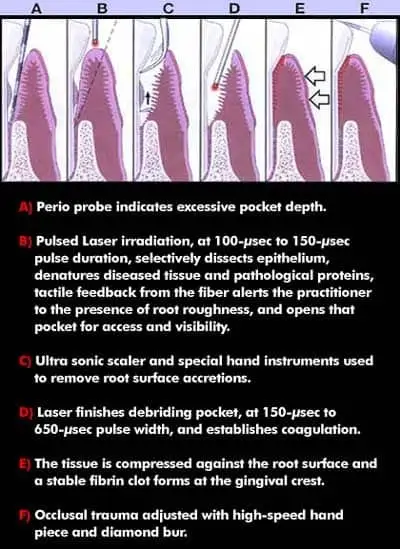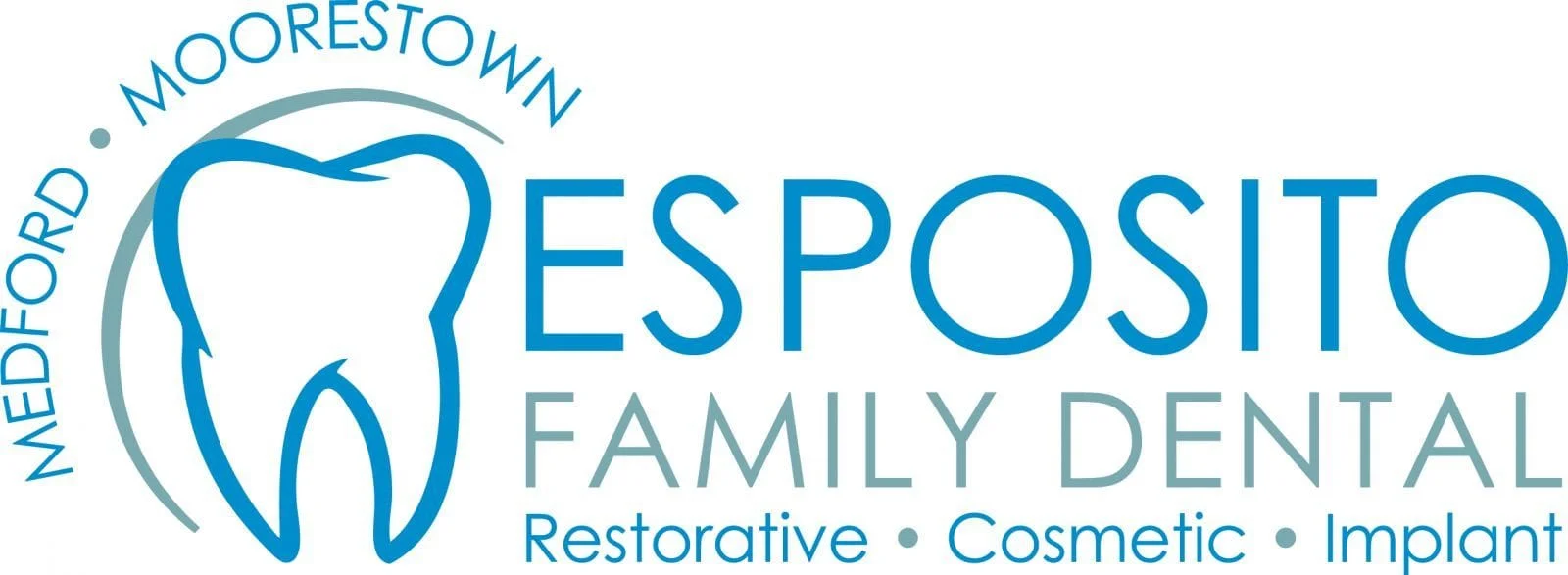Keeping on the leading edge of dental technology, we are proud to now offer an incredible breakthrough in the treatment of periodontal disease. LASER PERIODONTAL THERAPYTM (LPT) is an alternative to traditional scalpel and suture gum surgery. Millions of Americans suffer from periodontal disease, the major cause of tooth loss in adults.
Periodontal disease initially presents as plaque, an opaque film which eventually hardens, forming tartar or calculus. Calculus deposits harbor bacteria which infect the gums. In early stages, this is called Gingivitis, characterized by red, swollen gums that bleed when you brush your teeth. Many people experience bad breath and an unpleasant taste in their mouths as well. Unchecked, Gingivitis progresses to Periodontitis, a much more serious form of the disease where periodontal pockets are formed, separating teeth from the gums and supporting bone structure. Without treatment, infection becomes severe and the pockets deepen, resulting in tooth loss.
The way to repair the damage is to get rid of the infection and close up the pockets which traditionally involved surgery and sutures. But today, we offer LASER PERIODONTAL THERAPYTM (LPTTM), a patient-friendly, minimally-invasive procedure that's a great improvement over standard gum surgery.
THE PROCEDURE
In most cases, your dentist will schedule a complimentary consultation to explain how the laser works and give you a demonstration. Next, the dentist will take X-rays to make a definitive diagnoses and determine the extent of the infection. When you return for your first LPTTM treatment, you'll receive a local anaesthetic to eliminate any possible discomfort. A general anaesthetic isn't necessary, because LASER PERIODONTAL THERAPYTM is much less traumatic. A tiny laser fiber (about the thickness of three hairs) is inserted between the tooth and the gum, and the infection is cleared away. The procedure is fast: It takes just two 2-hour sessions. Your dentist will treat one half of your mouth at each session...and you'll probably feel good enough to go right back to work afterwards.

WHY IS LPT better?
- LPTTM is about as easy as erasing a blackboard -- there's no cutting and no suturing.
- There's much less discomfort with LASER PERIODONTAL THERAPYTM than with standard surgery -- during and after the procedure.
- It takes less time than traditional surgery. All it takes is two 2-hour visits to the dentist and two follow up visits. Traditional surgery requires four sessions of about one hour each, with subsequent visits for suture removal and additional check-ups.
- LPTTM gives better, longer-lasting results. In fact, 98% of LPTTM treated patients remain stable after five years, while only 5% reportedly remain stable after surgery.
- Your dentist will probably recommend a soft diet for a day or two, and common sense should prevail, but in most cases, patients feel good enough to eat anything they want right after the procedure.
- Following traditional surgery, recovery can take between to 2-4 weeks during which patients can experience considerable pain and swelling, where they may be restricted to liquid or soft diets.
- There's less than 24 hour recovery period, so you won't lose time from work.
- LASER PERIODONTAL THERAPYTM is safe for patients with health concerns such as diabetes, HIV, hemophilia, or those taking medications such as Coumadin or Cyclosporin.
What is Periodontal Disease?
It's an infection of the gums. It starts out as plaque, an opaque film on the teeth that hardens to form calculus or tartar. As tartar accumulates, it harbors bacteria which attacks the soft tissue around the gums. This early stage of gum disease is called Gingivitis. Symptoms include red swollen gums, bleeding, bad breath and, sometimes, an unpleasant taste in the mouth. Untreated, Gingivitis becomes Periodontitis. At this severe stage, bacteria destroys both the gums and the supporting bone structurel Pockets form where teeth are separated from the gums and surrounding bones. Left untreated, Periodontitis eventually results in tooth loss.
What's the best way to treat Periodontal Disease?
LASER PERIODONTAL THERAPYTM (LPTTM) a patented new non-surgical laser alternative to gum surgery, is a less painful, less traumatic way to treat periodontal disease at any stage.
What's different about LPTTM?
LPTTM uses a special kind of laser called the PerioLase®, invented by two dentists in Cerritos, California. Dr. Robert Gregg and Dr. Delwin McCarthy spent years developing a better way to treat gum disease. The laser fiber, which is only about as wide as a couple of human hairs, is inserted between the gum tissue and your tooth, where it painlessly removes the noxious elements that cause gum disease.
How many treatments will I need?
LPTTM doesn't take much time at all -- just two two-hour sessions versus eight to ten one-hour sessions with surgery. You don't have to worry about bleeding, stitches or post-treatment infection, because your gums haven't been cut.
What about recovery - will I be in pain or need to follow a special routine?
The sense of recovery is immediate, due to the laser's ability to seal blood vessels, lymphatics and nerve endings. Of course, your tissue needs time to recover, regenerate and heal over the course of time, but after LPTTM, you can drive your car, go back to work, or do anything else you like.
I can see how good LPTTMis - but is it very expensive and will my insurance cover it?
The good news is, LPTTM is actually less expensive -- by about 20% -- than periodontal surgery. Dental costs vary around the country, so find a PerioLase® dentist in your area for exact figures. There is no special code for our therapy, so if your insurance company will reimburse for conventional surgery, they will reimburse for LASER PERIODONTAL THERAPYTM, there's a If you're like 100 million other Americans, you could be one of 50% of Americans who have periodontal disease, the major cause of tooth loss in adults. Periodontal disease starts off as plaque, an opaque film which eventually hardens, forming tartar or calculus.
Calculus deposits harbor bacteria which infect the gums. In early stages, this is called Gingivitis, characterized by red, swollen gums that bleed when you brush your teeth. Many people experience bad breath and an unpleasant taste in their mouths as well. Unchecked, Gingivitis progresses to Periodontitis, a much more serious form of the disease where periodontal pockets are formed, separating teeth from the gums and supporting bone structure. Without treatment, infection becomes severe and the pockets deepen, resulting in tooth loss.
The way to repair the damage is to get rid of the infection and close up the pockets. Until now, that meant surgery and sutures. But today, many dentists offer LASER PERIODONTAL THERAPYTM (LPTTM), a patient-friendly, minimally-invasive procedure that's a great improvement over standard gum surgery.

